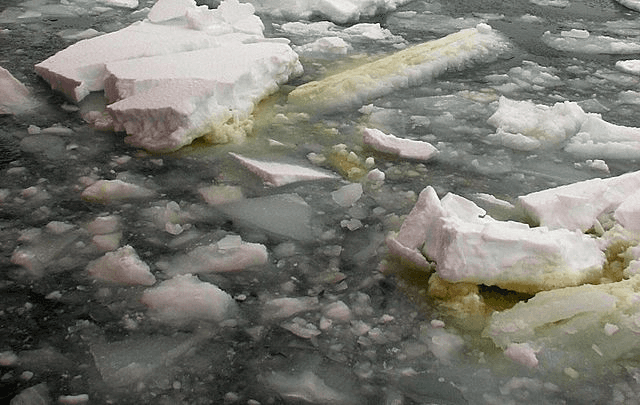
Jithin S Sunny
How do extremophiles thrive in hostile environments? Unique and incredible adaptations enable this formidable feat. From complex protein machinery to repair mechanisms, this piece discusses how some organisms thrive in extreme conditions.

Such alien-looking landscapes are often filled with life.
Image: Yellowstone, July 2015. Source: Wikimedia Commons
In the previous piece, we met thermophiles, organisms that can thrive at temperatures of 50℃ or more. We also saw a few examples of single-celled bacterial species exhibiting extremophilic characteristics. But there are multicellular organisms that are extremophilic too! They dwell in a wide range of habitats, from polar sea ice to hydrothermal vents. Some examples of multicellular thermophiles are protozoa Vorticella, which flourish in hot acidic waters; fungi Curvularia protuberata that live in the hot springs and crabs residing in deep-sea hydrothermal vents.

Collected from seamount on the Kermadec volcanic arc, the vent crab or Gandalfus puia.
Image Source: Wikimedia Commons
Psychrophiles or cold-loving organisms, on the other hand, grow at 20℃ or even below 0℃, offering a multitude of diversity too. Liparis fabricii is a species of fish found in the arctic seas of Greenland. Notothenia coriiceps is an Antarctic fish that survives at sub-zero temperatures. There is diversity in extremophiles at both unicellular and multicellular levels.
To understand how this diversity came about, we should take a closer look at the adaptations in these organisms.
A Look into Thermophilic Adaptations
Thermal adaptations are characterised by the composition of proteins in a cell and their unique structure. At high temperatures, thermophilic proteins utilise innovative designs, aided by unique amino acid sequences. The structure of a protein is vital for maintaining its function. Since amino acids are the building blocks of proteins, their arrangement and individual percentage determine the shape and properties of the protein.
A scientific study from 2015 indicated that small amino acids are generally not found in proteins of thermophiles. Whereas bulky hydrophobic (water-fearing) amino acids such as isoleucine and leucine, charged amino acids like aspartic acid, proline which is a rigid amino acid, are commonly found. The presence of these can give rise to stabilizing forces that allow the protein to survive high temperatures. But sometimes these proteins can misfold. Even a single nanometer shift from its native conformation can affect its optimal function. But these cells have adaptive features to respond to such situations. Let’s see how.
“Heat shock proteins” (HSPs) are the ones that avert misfolding-mediated disasters in cells. Although these are present in almost all life forms, the ones present in thermophiles are specialized. They assist in protein folding, thus maintaining the optimal shape of protein for its functionality. In an exciting study, scientists transferred these HSPs derived from thermophilic species to a bacterial cell. After the transfer, the cell retained its structure at temperatures as high as 100°C! Its original threshold for temperature was 40°C. Unique protein conformations along with supporting molecules keep thermophilic organisms safe and sound under such high temperatures.
Over to Psychrophiles — the cold ones!
Contrary to thermophiles, psychrophiles have more flexible proteins. The size of amino acids plays a significant role in this rigidity or flexibility. A larger amino acid can restrict the movement of a protein at low temperatures. So, it shouldn’t be a surprise that small amino acids are common in proteins of psychrophiles.
Psychrophiles have a few more tools under their belt.
Antifreeze proteins (AFPs) were thought to be a unique property of marine fishes that survive sub-zero temperatures. But soon various others like snow molds fungi, sea-ice diatoms and psychrophilic bacteria were observed to possess this protein too. While HSPs bind to other proteins to protect them, AFPs are ice-binding and block the surface of ice molecules to prevent their growth. This is not all. Psychrophiles also possess various cold-shock proteins (CSPs). Psychrobacter arcticus 273-4 is considered a model for life in freezing environments and scientists study this species to speculate on extraterrestrial life. At -6°C it was observed that various types of CSPs were generated by this species for its survival.
Although both CSPs and HSPs are present in most living organisms, they are produced only under stress. However, for extremophiles, these proteins are a part of their essential housekeeping cellular processes.

Antarctic diatom algae covering the underwater surface displays extreme psychrophilic behaviour.
Image Source: Wikimedia commons
These adaptations explain thermophilic and psychrophilic survival. But what about adaptations that allow the survival of organisms hiding in the deep sea? Those species have much more to worry about than just the harsh temperatures. Do you remember the bacterial genus Deinococcus from our previous article? It survives radiation. But how? This is still a mystery.
How did these extremophiles come to be? How did they evolve to gain such potential of surviving harsh environments? Watch out for the next article that describes how these organisms came to be!
This article is a part of the series — Enchanting Extremophiles and Where to Find Them!. Find the rest of the articles from this series here.
References
Dittel AI, Perovich G, Epifanio CE. Biology of the vent crab Bythograea thermydron: A brief review. Journal of Shellfish Research. 2008 Mar;27(1):63-77.
Moon S, Kim J, Bae E. Structural analyses of adenylate kinases from Antarctic and tropical fishes for understanding cold adaptation of enzymes. Scientific reports. 2017 Nov 22;7(1):1-2.
Venev SV, Zeldovich KB. Thermophilic adaptation in prokaryotes is constrained by metabolic costs of proteostasis. Molecular Biology and Evolution. 2018 Jan 1;35(1):211-24.
Panja, A.S., Bandopadhyay, B. and Maiti, S., 2015. Protein thermostability is owing to their preferences to non-polar smaller volume amino acids, variations in residual physico-chemical properties and more salt bridges. PloS one, 10(7), p.e0131495.
Laksanalamai P, Maeder DL, Robb FT. Regulation and Mechanism of Action of the Small Heat Shock Protein from the Hyperthermophilic ArchaeonPyrococcus furiosus. Journal of bacteriology. 2001 Sep 1;183(17):5198-202.
DeVries AL, Wohlschlag DE. Freezing resistance in some Antarctic fishes. Science. 1969 Mar 7;163(3871):1073-5.
Kuhn E. Toward understanding life under subzero conditions: the significance of exploring psychrophilic “cold-shock” proteins. Astrobiology. 2012 Nov 1;12(11):1078-86.





